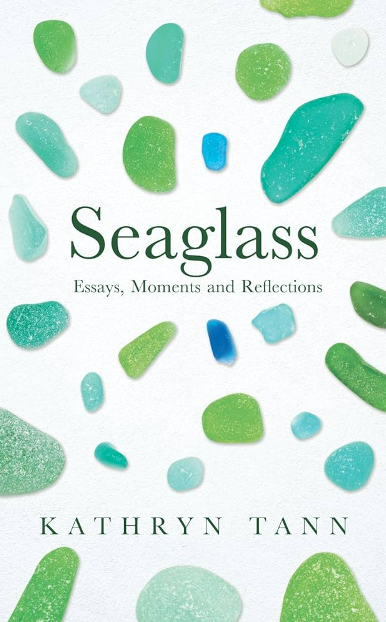
Kathryn Tann | Seaglass | Calon: £16.99
Reviewed by Joseph Hunter
Seaglass, the debut essay collection by Kathryn Tan, is best described as part memoir, part nature writing – and there is a great deal of beauty in Tann’s explorations of the crossover between these two things. The collection clearly owes something to the ongoing rise or rebirth of autofiction, that strangely malleable genre marked, as David Shields argues in Reality Hunger (2010), by (among other things) ‘plasticity of form… criticism as autobiography; self-reflexivity, self-ethnography’. All of these things are detectable in Seaglass.
The collection, however, establishes its own intertextuality. ‘The Nature of Change’, which appears in the centre of the book, contains quotations from Thomas Halliday’s Otherlands (2022) and Robert McFarlane’s Underland (2019), indicating the kinds of contemporary non-fiction Seaglass is in conversation with. The piece in question is an excellent example of Tann’s auto(non)fiction, exploring her personal experiences of landscapes changed by human activity, and nature’s inexorable ability to renew even if in a different, changed form.
It is tempting to make a connection between sea glass – jewel-like pieces of coloured glass worn smooth by tides and discovered on certain beaches – and Tann’s prose. Sure enough, her writing is by turns polished, smooth, and refined. However, it also contains more character than such an analogy suggests. Tann, an alumna of the University of Manchester’s Creative Writing MA, does not offer prose that is unblemished and workshopped, but that instead is searching, open, and generous. For example, ‘Between Lines’ attempts to defy the passing of time by holding onto moments as if in cupped hands, offering them to the reader: ‘Flight trails, still lit, seam the sky, which has swallowed its ruby and is ready for sleep.’ This is not the ordinary being crafted or gilded, but the beauty in the ordinary being revealed.
This unguarded, generous approach extends to the novel’s paratext, namely the line drawings of flora by Tann that are interspersed between the essays. Drawings that are sometimes almost childishly simple (one drawing of a clover is composed of perhaps half a dozen pencil strokes), but beautiful for that in their frailty and simplicity. Alongside these drawings are short, present-tense descriptive vignettes. These word drawings are written in the second person, and feel immersive and immediate:
You know that somewhere in amongst those trees, roots grasp the skeleton of a long-lost home. Stone sinks into its soft pine needle bed. Stone lies angular and velvety.
The essay from which the collection takes its title, ‘On Collecting Sea Glass’, is concerned with something timely: the need to search for hope and beauty within the gloom. Tann searches the beach for sea glass, and in so doing describes it as a liminal space where people gather to obey unarticulated yearnings within themselves. The sea glass, like the described moments offered as numbered ‘records’, are manifestations of a ‘private list of silver linings’ now made public.
Tann is intimately in touch with the magic of childhood memories, which are often evoked through satisfying sensory description. And, indeed, an important theme in the collection is the transition from childhood to adulthood. ‘Return to Water’ is an essay about her journey to womanhood as told through her fraught relationship with swimming and water. Here the agonising and tender trials of adolescence are poignant too – in her case complicated by severe acne, a common but devastating experience rarely so well-scrutinised as it is here. ‘Pearly Queen’ and ‘To Make the Perfect Gravy’ also feature forays into childhood joy. The latter piece is a delicious account of a child’s greed maturing into an adult gourmet’s complex relationship with food, and like a good meal the whole is much greater than the ingredients (sumptuous descriptions of food-memories, ingredients, pleasures) of which it is composed.
Seaglass is, however, a product of the present historical moment; it captures the shared present, though imbued with Tann’s subjectivity. The shadow of the COVID-19 pandemic and accompanying lockdowns overhangs many of the essays, as well as the still-undealt-with psychic fallout of those times. ‘Unmoored’ provides a perceptive critique of smartphone ownership/attachment, which rather than decrying our reliance on such devices explores instead the ever-present awareness of performance, record-keeping, and filtering that has entered our consciousnesses. The piece that follows, ‘Collins English Gem’, celebrates the book-as-object, while ‘Mountain Pools and Neoprene’ is concerned with Tann’s personal (and female) experience of the contemporary craze for wild swimming.
Tann’s own authorial presence in these pieces – as narrator and human being – is both beguiling and weighty. The impression is of a studious, earnest, and sensitive mind that has little time for frivolous pleasures. The essays see her seeking out wholesome, spiritually- and physically-rewarding pursuits: early-morning swims, focussed study, guided hikes. One piece contains a casual mention of finishing a day’s work at almost 10pm at night, just in time for a spot of dictionary-reading (that classic nightcap!) before bed. The fact that this almost professorial persona never becomes wearing or self-parodic is testament to the lyrical earnestness with which each of these episodes is treated, and the self-searching honesty that runs through the collection like a golden thread.
Seaglass concludes with ‘New Year’s Day’, a record of an annual (and hazardous) pilgrimage to a wild stretch of Welsh cliff. Though short, the piece achieves in miniature what the collection as a whole aims to do. It evokes the personal and individual through contact with the impersonal and the wild. Ironically it is by engaging with memory near and far, capturing the beauty of the moment, and communing with what lies beyond the self that Seaglass marks a personal new beginning for its debut author.
By Joseph Hunter
